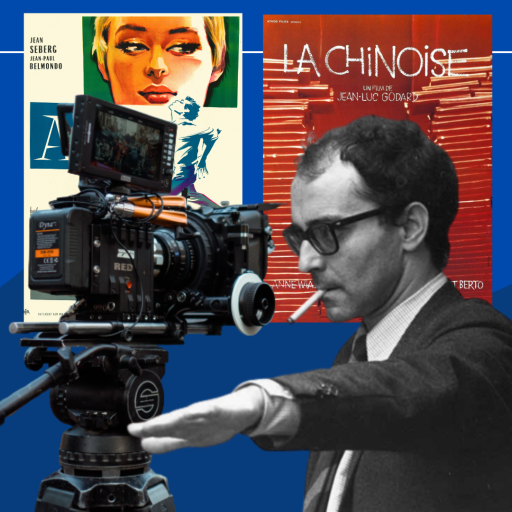Alienation of Cinema: Jean Luc Godard
15 Ekim 2022Mustafa Taha Kendirligil
Cinema is a child of modernism. In other words, cinema and modernism are inseparable from each other. Modernism denies socially canonical ideas that have lasted for a long time in human history. So, there is no room for concepts such as realism, sentimentalism, or other thoughts that were popular in the 19th century. Therefore, rather than using those ideas, modernism focuses on manipulating the realistic experience people perceive every day. In order to accomplish that idea, cinema is mainly used to alter conventional notions in society.
Modernist cinema has distinct features. One of the essential aspects of modern cinema is the montage, which allows different images to be brought together to create effects. Modernist directors benefited from the advantages of montage to give implicit expressions to the viewer. Symbolism and imagery are frequently used in modern cinema as well. While symbols build connections between the director’s intentions and the viewer, objects are often used for that exact purpose too. In addition, images can give hints to relate to the director’s goal too. If modern directors exclude those techniques, their films would not be interesting and striking to the viewer’s feelings that much.
Jean-Luc Godard is a distinctive figure when we talk about these features of modern cinema. He successfully integrated those features into his films. His montage technique is more distinctive than that of other directors. In his period, films were smooth and mostly followed a “logical” cut. On the other hand, Godard utterly demolished and reconstructed the definition of the cuts in his scenes. In his films, cuts are irregular, and there are quick jumps between different scenes. Symbols and imagery play a huge role in his films as well. While a character tells a story, pictures related to the story are shown to the viewer. Another distinctive aspect of Godard’s films is the camera angle. While we watch a conversation between characters, Godard shows the same frame or focuses on only one character who speaks to another individual.
Godard (1960) made a breakthrough in his debut film “Breathless” about conversations between characters, cut scenes, and camera angle. Our main characters are Michel, a reckless car thief, and Patricia, who works in an American newspaper company. Dialogues between those characters are ordinary and simple. We usually don’t come across exciting or gripping talks. They talk about their dreams and what they will do in the future. When he is stopped by a police motorcycle patrol, Michel kills a police officer; yet he does not care about what he did and instead focuses on his minor problems (Godard, 1960, 00:05:42). Even though we exclude other innovative features of that film, that contradiction alone makes it an interesting film to watch. Apart from that contradiction, Godard uses the alienation effect where familiar contents do not follow a certain path in the cuts; thus, the viewer cannot develop any emphatical notions towards the drama of the cinema. For example, as we see Michel and Patricia talking to each other, the scene suddenly changes, and Michel is seen on the corner of a street (Godard, 1960, 01:26:50). Final innovative technique is his way of using the camera angle compared to standard Hollywood camera angle techniques. In this film, the camera does not shift from one character to another when they start a conversation.
After that innovative film, Godard focused on shooting political films. “La Chinoise” is a touchstone if we want to comprehend his political films. The film (1967) was adapted from Dostoevsky’s novel Demons (1872). In Dostoevsky’s book, there are five different characters who want to overthrow the Russian imperial regime. As in Dostoevsky’s novel, we also have five distinct characters in the film. They are university students who are also sympathizers of a young Maoist group and call themselves the “Aden Arabie Cell.” The film mostly takes place in an apartment. Godard continues to stamp this film with his signature techniques. It has a lot of alienation effects. The film also communicates to the viewer in order to disrupt the film’s boundaries with the viewer. As Guillaume talks about his political beliefs, he talks to the film crew, and the camera locks on the viewer (Godard, 1967, 00:08:52).
Godard continued to shoot more political films in his subsequent years. He criticizes the capitalist system in his film called “Tout Va Bien.” The film dates back to 1968-1972 years in France. One of our main characters is Jacques, whose job used to be directing films, but he quit his former job and started to shoot advertisements. The other main character is Suzanne, who works in an American newspaper company like Patricia. The couple wants to see a manager in a sausage factory, but the factory workers are on strike. After they arrive at the factory, the couple experiences the class struggle (Godard, 1972, 00: 08:36). Apart from the political side of the film, Godard continues to use the alienation effect as he used in “La Chinoise” and “Breathless.” For instance, Jacques directly speaks to us. He talks about why he resigned from his former job and chose to shoot adverts. He also adds that he encountered financial problems after the May 1968 civil riot against the government (Godard, 1972, 00:54:09). As a result, viewers are estranged and become conscious that they are watching a film. The camera angle also contributes to that phenomenon of being more “realistic.” For example, while revolutionists are flocking a supermarket, the camera angle shifts from right to left and vice versa rapidly (Godard, 1972, 01:29:24).
Godard brought lots of innovative techniques to the cinema. His utilization of camera angles and alienation effect and his use of symbolism and imagery had characteristic modernist features. Godard states, “A story should have a beginning, a middle, and an end… but not necessarily in that order.” This indicates that directors do not need to follow the same pattern as Hollywood. Moreover, he completely disrupted the distance between the viewer and the film. His characters directly speak to the viewer or the film crew. Furthermore, conversations between characters are too simple, like everyday life dialogues. Finally, Godard utilized his films as a tool to reflect his political beliefs. Therefore, he could criticize capitalism, class segregation, or inequality in his films. Godard has a special place in the history of modern cinema because of his innovative cinematic techniques.
References
- Godard, J. (Director). (1960). À bout de souffle [Breathless] [Film]. The Criterion Collection; Janus Films; Pretty Pictures.
- Godard, J. (Director). (1967). La Chinoise [The Chinese] [Film]. Gaumont.
- Godard, J. (Director). (1972). Tout Va Bien [Everything is going well] [Film]. Gaumont.

